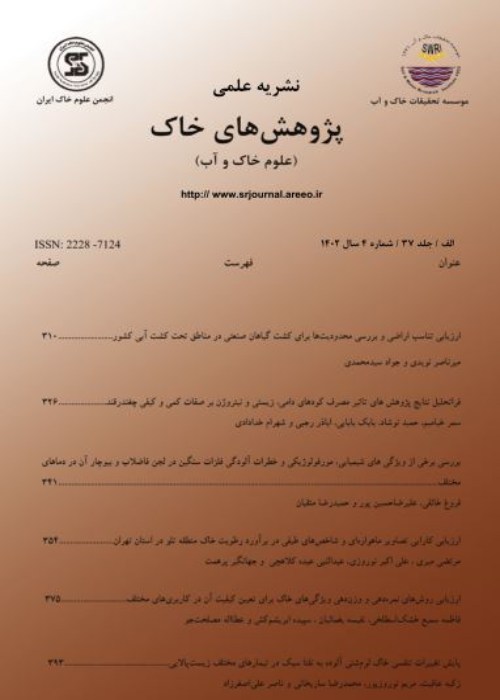Effect of Rotation, Management of Nitrogen Application, and Plant Residue on Corn (cv.SC704) Yield and Some Soil Chemical Properties
Author(s):
Abstract:
Environmental problems and instability of agricultural production has caused attracted special attention to those agronomic practices, such as determining the appropriate previous croprotation, management of crop residues, and the optimal use of fertilizers, especially nitrogen, particular attention should be. So, in order to study the effect of rotation (previous crops) and crop residue management on nitrogen application rate in corn (Zzea mays.L cv. SC704) planting and some of the soil chemical properties, this expereiment was conducted in 2008-2012 at Safiabad Agricultural Research Center, Dezful. The experiment was conducted as split- factorial in randomized complete block design with 16 treatments and three replications. Two levels of rotation (canola-corn and wheat-corn) were assigned to the main plots and nitrogen at four levels (0,100, 200, and 300 kg ha-1) and crop residue at two levels (maintaining all of crop residue and complete removal of crop residue) as factorial were randoimized in sub-plots. The results showed that the main effect of rotation on corn grain and biological yields and other traits were not significant. The main effect of nitrogen application had significant effects on corn grain and biological yields, 1000-grain weight, grain protein, nitrogen utilization efficiency, and organic carbon and available phosphorus and potassium after harvesting., Indeed, so that with nitrogen application, the mentioned indices parameters, except nitrogen utilization efficiency, increased. The main effect of crop residue on the studied traits was significant, except grain protein and nitrogen utilization efficiency. The effect of nitrogen and residue management on soil organic carbon was significant. With the increase of in nitrogen application rate and in the treatment maintaininged the crop residue, treatment compared with the removed- residue treatment, soil organic carbon increased. In general, the highest yields of grain (7724 kg ha-1) and biological biomass (14273 kg ha-1) were obtained from maintaining all of crop residue in conjunction with nitrogen application at the rate of ( 200 kg ha-1). Therefore, regarding to the condition of this experiment, application of 200 kg N ha-1 in combination with maintaining of the crop residue is recommended for corn production in this region.
Keywords:
Language:
Persian
Published:
Iranian Journal of Soil Research, Volume:30 Issue: 2, 2016
Pages:
115 to 124
magiran.com/p1577837
دانلود و مطالعه متن این مقاله با یکی از روشهای زیر امکان پذیر است:
اشتراک شخصی
با عضویت و پرداخت آنلاین حق اشتراک یکساله به مبلغ 1,390,000ريال میتوانید 70 عنوان مطلب دانلود کنید!
اشتراک سازمانی
به کتابخانه دانشگاه یا محل کار خود پیشنهاد کنید تا اشتراک سازمانی این پایگاه را برای دسترسی نامحدود همه کاربران به متن مطالب تهیه نمایند!
توجه!
- حق عضویت دریافتی صرف حمایت از نشریات عضو و نگهداری، تکمیل و توسعه مگیران میشود.
- پرداخت حق اشتراک و دانلود مقالات اجازه بازنشر آن در سایر رسانههای چاپی و دیجیتال را به کاربر نمیدهد.
In order to view content subscription is required
Personal subscription
Subscribe magiran.com for 70 € euros via PayPal and download 70 articles during a year.
Organization subscription
Please contact us to subscribe your university or library for unlimited access!


